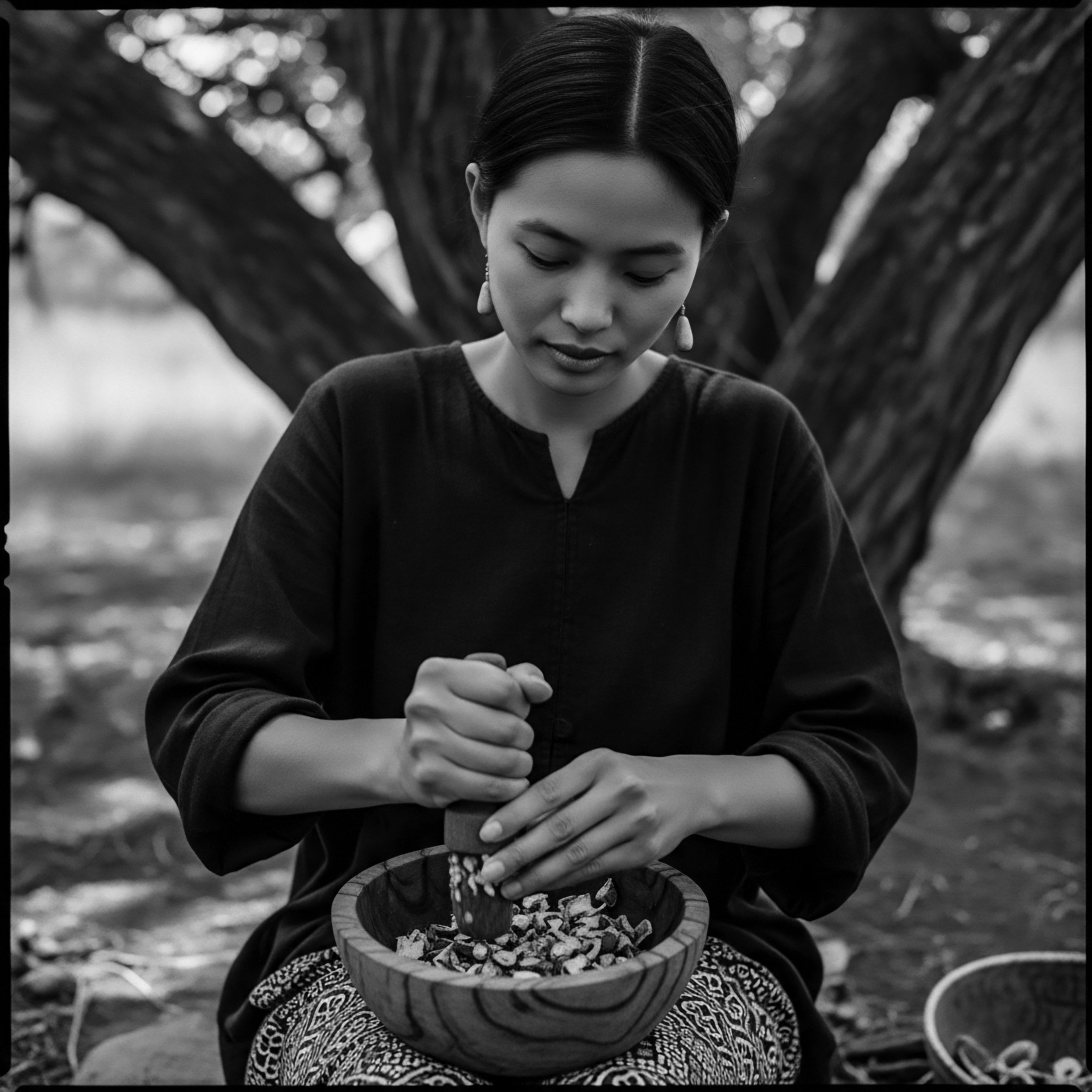
Fundamentals
The concept of Ancient Hair Care, within Roothea’s ‘living library,’ denotes a profound recognition of ancestral wisdom and time-honored practices that nurtured textured hair across civilizations. It is not merely a historical curiosity; rather, it stands as a testament to the ingenious methods, natural resources, and communal rituals that sustained scalp and strand health long before the advent of modern cosmetic chemistry. This foundational understanding centers on the deep connection between hair, identity, and the very spirit of a people, particularly within Black and mixed-race communities. From the elemental biology of the hair fiber to the elaborate styling techniques, these practices formed an integral part of daily life, communicating social standing, spiritual beliefs, and community ties.
At its core, Ancient Hair Care represents a collective body of knowledge passed through generations, emphasizing natural ingredients sourced directly from the earth. These included a diverse array of plant-based oils, butters, clays, and herbal infusions. The application of these materials was rarely a solitary act; it was often a communal gathering, a moment for bonding and shared wisdom, solidifying cultural heritage through touch and shared experience. This initial perception of Ancient Hair Care reveals its dual role ❉ both a practical approach to physical well-being and a potent symbol of cultural continuity.

Echoes from the Source ❉ Elemental Nurturing
The earliest manifestations of Ancient Hair Care reveal a profound attunement to the natural world. Indigenous communities observed the properties of local flora and fauna, discerning which elements offered protection, cleansing, or nourishment for the hair and scalp. The elemental components of this care often involved water, sunlight, and the bounty of the land itself.
Water, for instance, was not just for cleansing; it was often infused with herbs or mineral-rich clays to provide a deeper, more therapeutic treatment. Sunlight, a natural source of warmth, assisted in drying and often in the activation of certain plant properties.
Consider the widespread use of various plant oils. In numerous African societies, oils derived from shea, palm, or coconut served as primary emollients, providing lubrication and sealing moisture into the hair fiber. These substances, often rendered through meticulous, labor-intensive processes, were not just applied to the hair; they were worked into the scalp, promoting circulation and addressing underlying skin conditions. This comprehensive approach, addressing both the visible hair and its root system, underscores a holistic understanding of well-being that permeates ancestral practices.
Ancient Hair Care signifies a deep reverence for ancestral practices, intertwining natural elements with communal rituals to foster textured hair health and cultural continuity.
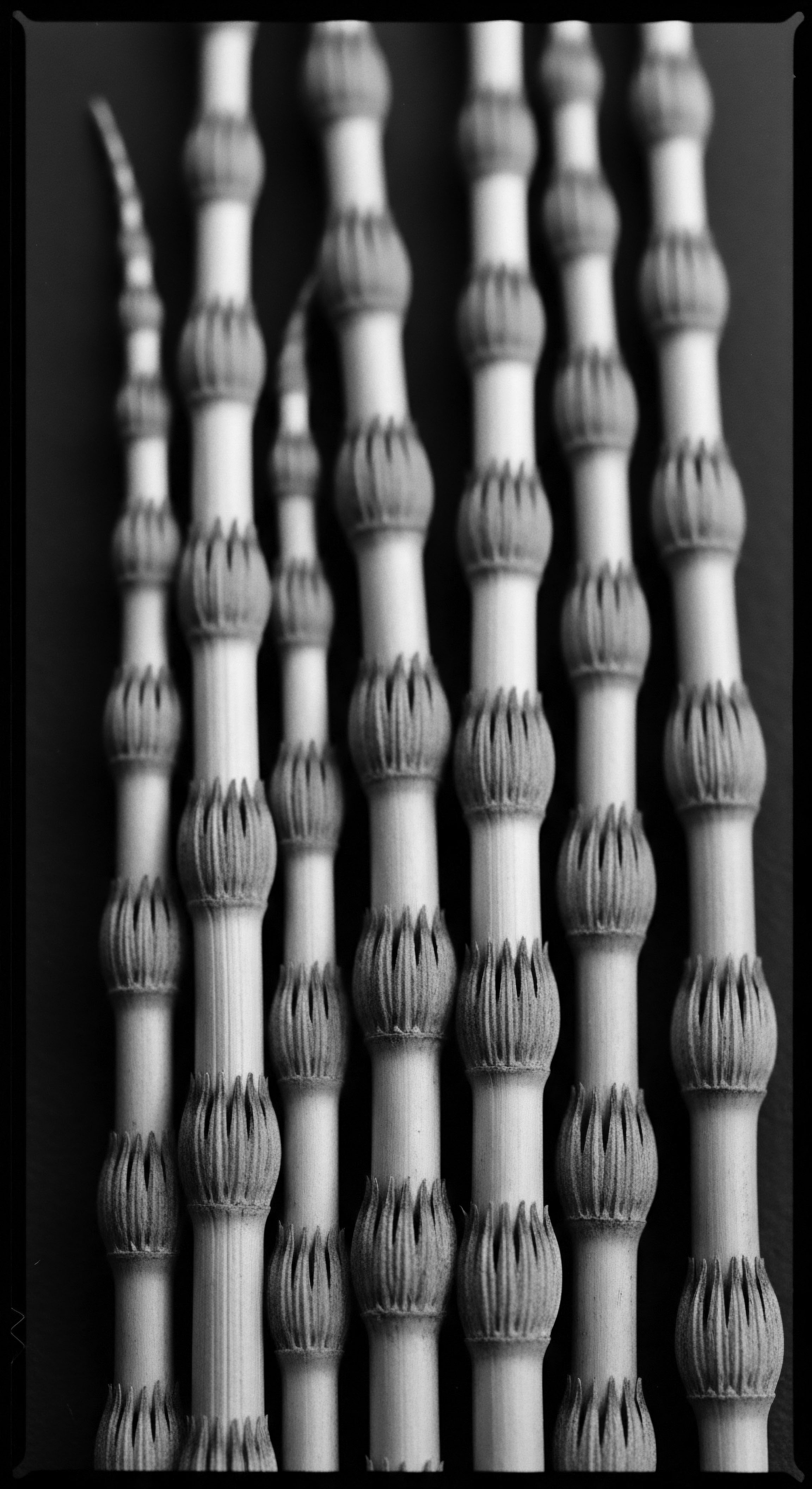
Ancestral Ingredient Wisdom
The discernment of beneficial ingredients formed the bedrock of Ancient Hair Care. Each plant, each mineral, held a specific purpose, often rooted in generations of observation and experimentation. The wisdom of these early practitioners was akin to a living ethnobotany, where knowledge of the environment translated directly into effective personal care.
- Shea Butter ❉ A staple across West Africa, derived from the nuts of the shea tree, revered for its emollient properties and its ability to seal moisture into textured strands.
- Palm Oil ❉ Utilized in various African regions, offering rich conditioning and protection against environmental elements, contributing to hair’s suppleness.
- Aloe Vera ❉ Valued for its soothing and hydrating qualities, applied to the scalp to alleviate irritation and condition the hair shaft.
- Clay ❉ Often used for cleansing and detoxification, drawing impurities from the scalp while imparting beneficial minerals.
- Herbal Infusions ❉ Preparations from plants like rosemary, hibiscus, or moringa, applied as rinses or masques to strengthen hair, stimulate growth, or enhance natural color.
These components, far from being mere cosmetic agents, were perceived as sacred gifts from the earth, their application imbued with respect and gratitude. The processes of preparing these ingredients—grinding, infusing, whipping—were often rituals in themselves, reinforcing the cultural value placed upon hair and its care.
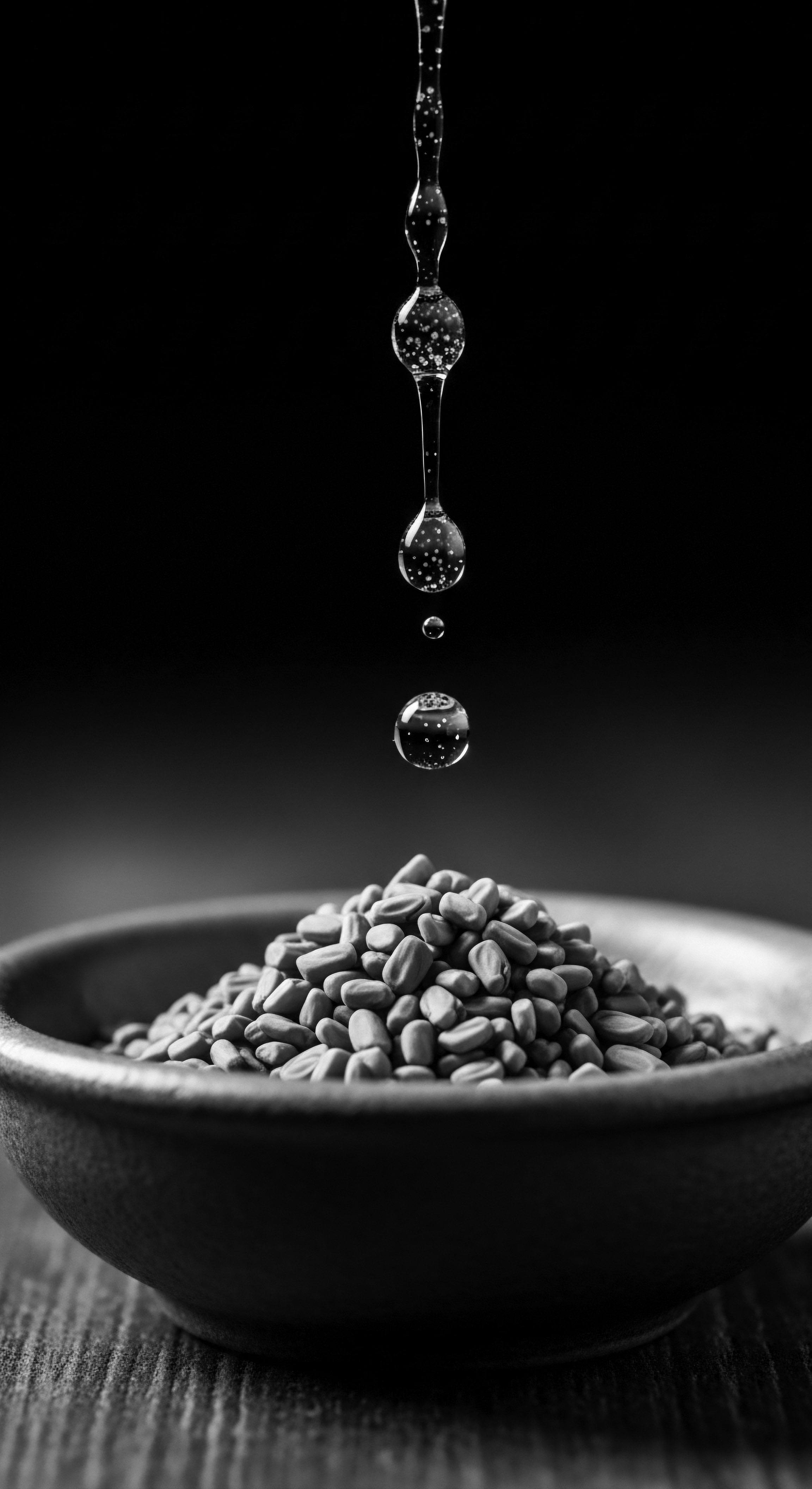
Intermediate
The intermediate meaning of Ancient Hair Care extends beyond foundational principles, focusing on how these heritage practices, especially those for textured hair, have been carefully passed down and adapted through time. This definition recognizes Ancient Hair Care as a dynamic system of knowledge, one that responded to environmental shifts, societal changes, and the dispersal of peoples across continents. It was not static; instead, it demonstrated a remarkable capacity for resilience and reinvention, preserving cultural memory within each strand.
The methods of transmission were largely oral and experiential, from elder to youth, mother to child, within the intimate settings of family and community. These practical applications were woven into the very fabric of daily life, evolving into sophisticated rituals that sustained both physical hair health and collective identity. The continuity of these traditions, even when faced with disruption, speaks volumes about their inherent value and the deep-seated significance of hair within Black and mixed-race cultural legacies.
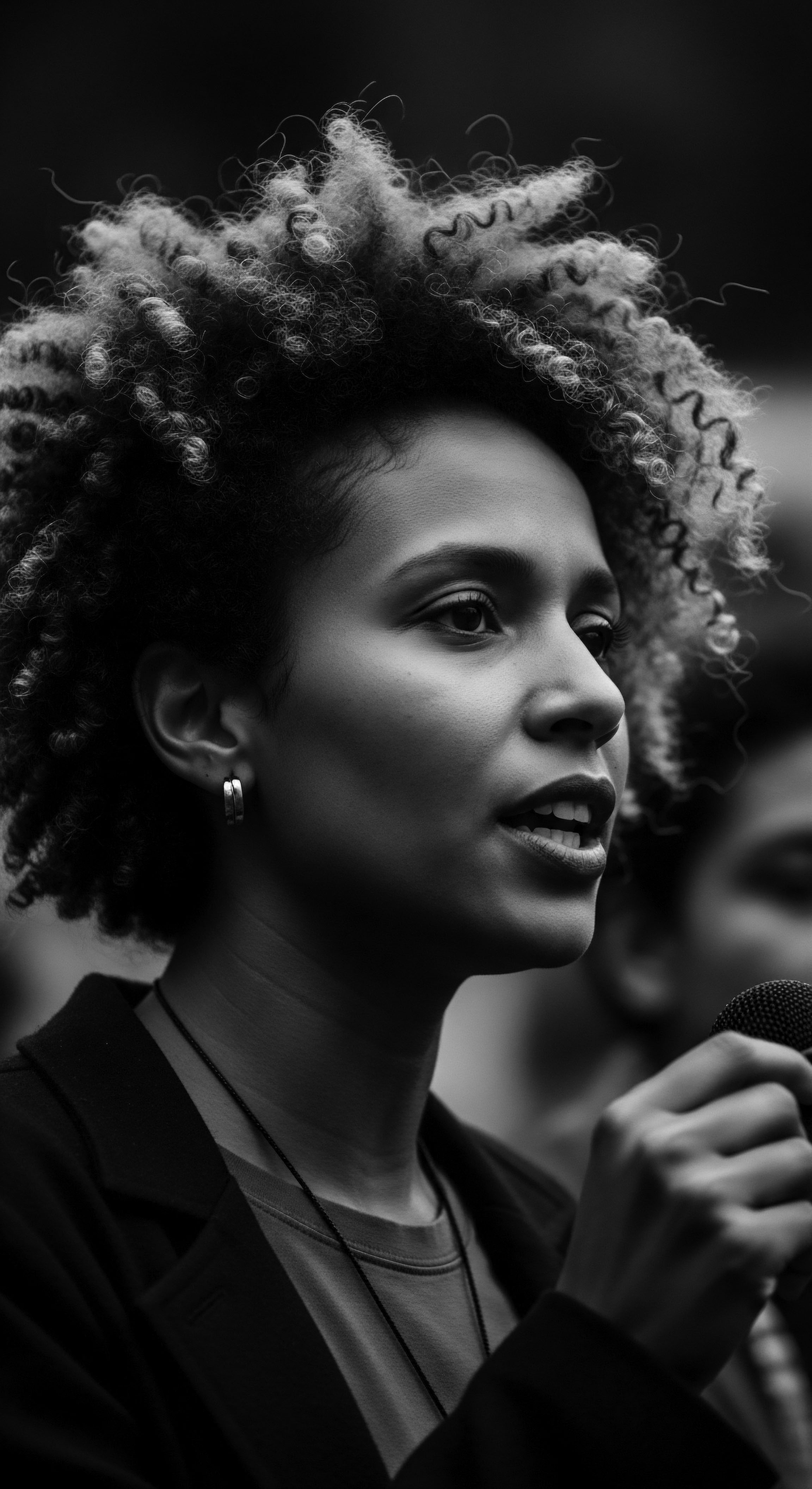
The Tender Thread ❉ Living Traditions and Community Bonds
The application of Ancient Hair Care was rarely a solitary pursuit. It blossomed within communal spaces—the village square, the family hearth, the bustling marketplace. These were not simply acts of grooming; they were social events, opportunities for storytelling, mentorship, and the strengthening of intergenerational connections. The rhythmic sound of combs, the scent of warmed oils, the gentle touch of hands on hair—these sensory experiences became conduits for cultural transmission, each movement a lesson, each style a symbol.
For instance, the practice of braiding, a cornerstone of textured hair care across Africa and its diaspora, transcends mere aesthetics. In many West African societies, the intricacy of a braid pattern could communicate a woman’s marital status, her age, her tribal affiliation, or even her readiness for a particular life stage. The hours spent in this communal activity allowed for the sharing of wisdom, the imparting of values, and the reaffirmation of belonging. It fostered a profound sense of collective identity and support.
Ancient Hair Care signifies a living legacy, where heritage practices for textured hair have been transmitted through communal rituals, preserving cultural memory and fostering identity across generations.
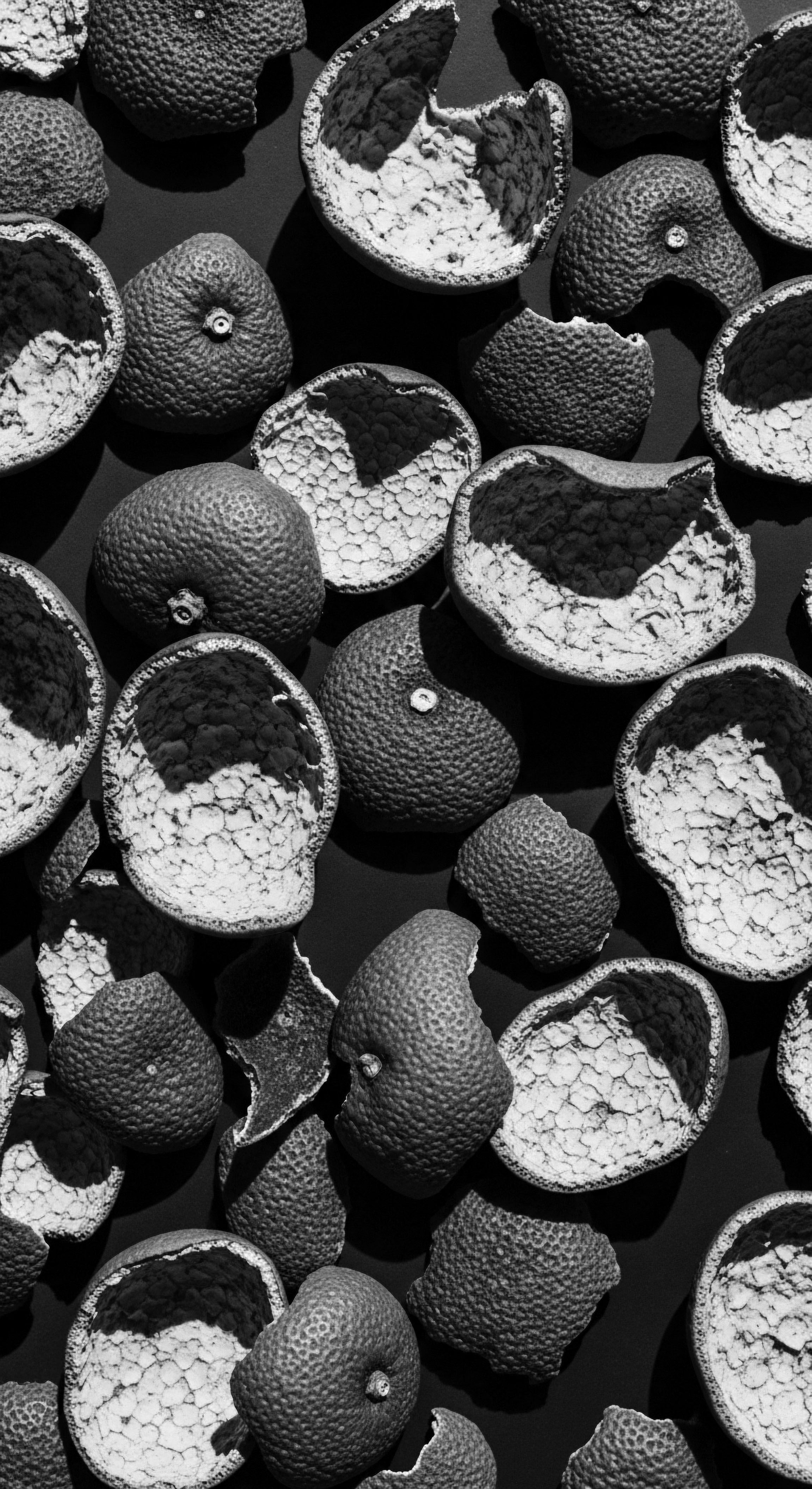
Continuity and Adaptation in the Diaspora
The transatlantic passage presented immense challenges to these traditions. Enslavement sought to strip individuals of their identity, often beginning with the forceful shaving of hair. Yet, even in the face of such brutality, the spirit of Ancient Hair Care persisted.
Enslaved Africans, denied access to traditional tools and ingredients, adapted with remarkable ingenuity, utilizing what was available to maintain a semblance of care and connection to their heritage. This adaptation was a silent, powerful act of resistance, a way to hold onto a piece of self and ancestry.
Later, as communities formed in the diaspora, these practices continued to evolve. The introduction of new materials and the influence of different climates led to innovations, yet the underlying principles of moisture retention, protective styling, and scalp nourishment remained. The communal aspect of hair care, though sometimes shifting from large village gatherings to smaller, intimate settings like kitchen chairs or beauty salons, continued to serve as a vital space for cultural exchange and affirmation. The enduring presence of styles like cornrows, Bantu knots, and various forms of braiding across the diaspora stands as a testament to this continuous thread of heritage.
| Traditional Practice (Pre-Colonial Africa) Use of natural oils (shea, palm, coconut) for moisture and protection. |
| Modern Adaptation (Diaspora) Incorporation of natural oils and butters into modern formulations (leave-ins, deep conditioners) for textured hair. |
| Traditional Practice (Pre-Colonial Africa) Communal braiding sessions for intricate styles and social bonding. |
| Modern Adaptation (Diaspora) Braiding salons as cultural hubs; at-home braiding sessions as family rituals. |
| Traditional Practice (Pre-Colonial Africa) Application of herbal infusions and clays for cleansing and scalp health. |
| Modern Adaptation (Diaspora) Development of sulfate-free shampoos and masks with botanical extracts for gentle cleansing and nourishment. |
| Traditional Practice (Pre-Colonial Africa) Protective styles (threading, elaborate braids) for length retention and damage prevention. |
| Modern Adaptation (Diaspora) Continued popularity of protective styles (braids, twists, locs) to guard against environmental stressors and breakage. |
| Traditional Practice (Pre-Colonial Africa) These adaptations underscore the enduring principles of Ancient Hair Care, demonstrating its timeless relevance for textured hair. |
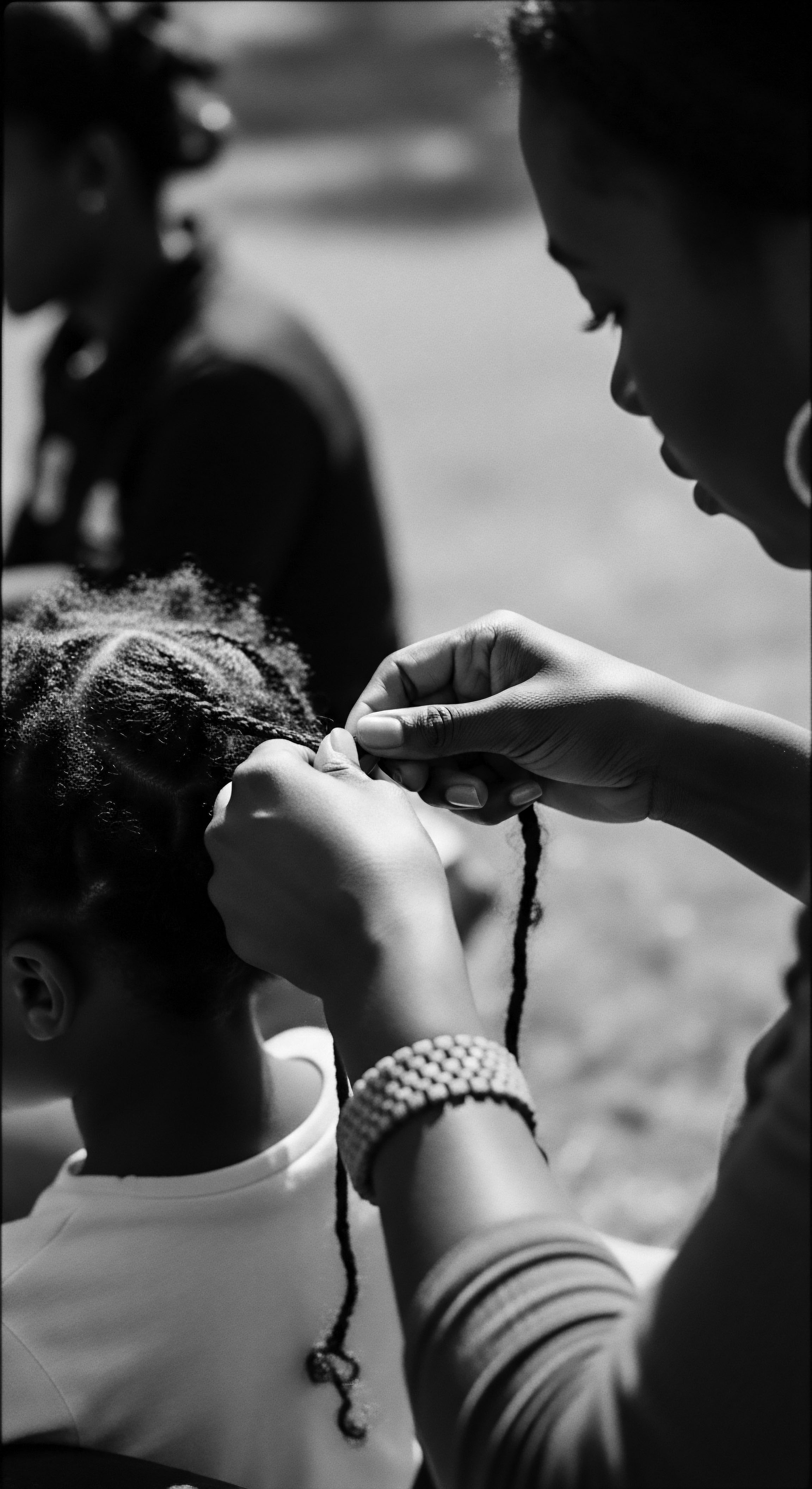
Academic
The advanced interpretation of Ancient Hair Care transcends a simple historical account, representing a complex, multi-layered framework for understanding the biological, socio-cultural, and psychological dimensions of textured hair. It constitutes a profound elucidation of ancestral methodologies, their inherent scientific underpinnings, and their enduring resonance within the Black and mixed-race hair heritage. This academic lens positions Ancient Hair Care not as a relic of the past, but as a living, breathing body of knowledge, continually informing contemporary practices and scientific inquiry. It is a testament to the profound empirical observation and practical ingenuity of pre-modern communities, often validating their wisdom through the rigor of modern scientific scrutiny.
This explication delves into the intricate interplay of biological factors specific to textured hair, such as its unique coil patterns, cuticle structure, and propensity for dryness, and how ancestral practices precisely addressed these inherent characteristics. It also examines the anthropological significance of hair as a primary medium for cultural expression, social stratification, and spiritual connection across diverse African societies and their diasporic manifestations. The historical trajectory of Ancient Hair Care reveals its role as a consistent marker of identity, resilience, and resistance, particularly in the face of oppressive systems that sought to diminish its significance.
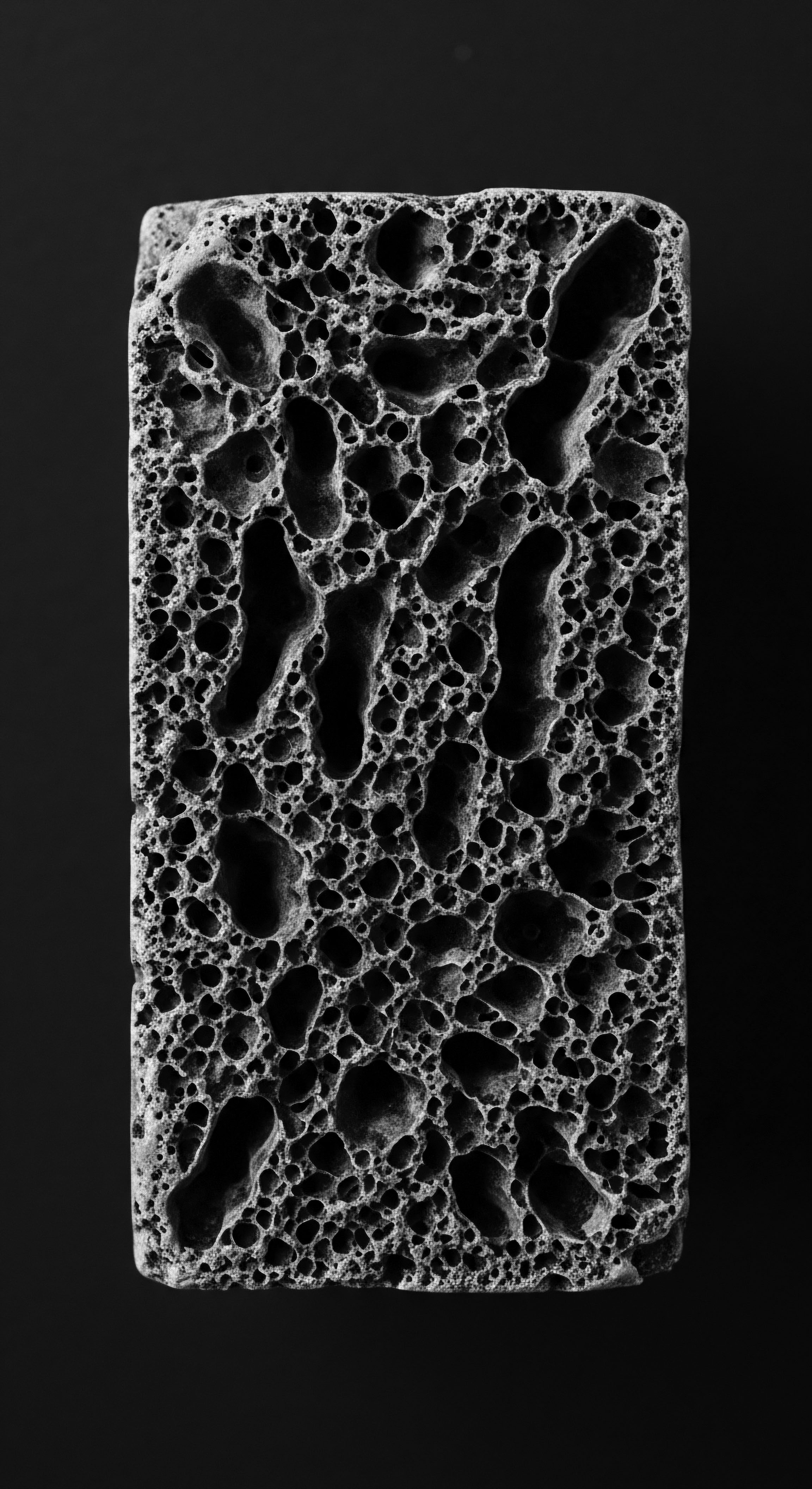
The Unbound Helix ❉ Identity, Science, and Future Trajectories
From an anthropological standpoint, the symbolic weight of hair in many African societies is immense, serving as a non-verbal language system. Hairstyles conveyed marital status, age, lineage, and spiritual devotion, operating as visual narratives of an individual’s life journey and community standing. For instance, among the Yoruba people of Nigeria, hair was perceived as the most elevated part of the body, a conduit for spiritual connection. Intricate braided styles were not merely ornamental; they served as potent messages to deities, embodying a deep cosmological understanding of the human form (Omotos, 2018).
This reverence for hair permeated daily life, making its care a sacred and communal activity. The extensive process of washing, oiling, braiding, or twisting, often taking hours or even days, created opportunities for social cohesion, reinforcing familial and community bonds (Omotos, 2018). These gatherings were pedagogical spaces, where younger generations absorbed the practical skills and the deeper cultural meanings embedded within each stroke of the comb or each strand intertwined.
A specific historical example powerfully illuminates this connection to textured hair heritage ❉ the traditional Chébé powder ritual of the Bassara (or Baggara Arab) women in Chad. This practice, documented as early as the 15th century, involves a meticulous regimen of applying a mixture of Chébé powder (derived from the seeds of the Croton zambesicus plant) with animal fat or oil to the hair, which is then braided. The women of this tribe are renowned for their exceptionally long, robust hair, which they attribute to this ancestral method. The powder is believed to coat the hair shaft, reducing breakage and thereby contributing to significant length retention, rather than directly stimulating growth (Omotos, 2018).
This centuries-old practice, passed down through generations, exemplifies a sophisticated, empirically developed understanding of hair protection and maintenance, perfectly suited to the unique characteristics of highly textured hair. The persistent use of Chébé today, even gaining global recognition, underscores the enduring efficacy and profound cultural significance of this specific form of Ancient Hair Care.
Ancient Hair Care, viewed academically, reveals itself as a sophisticated, empirically validated system of knowledge, where ancestral practices for textured hair intricately merge biological understanding with profound socio-cultural and spiritual dimensions.
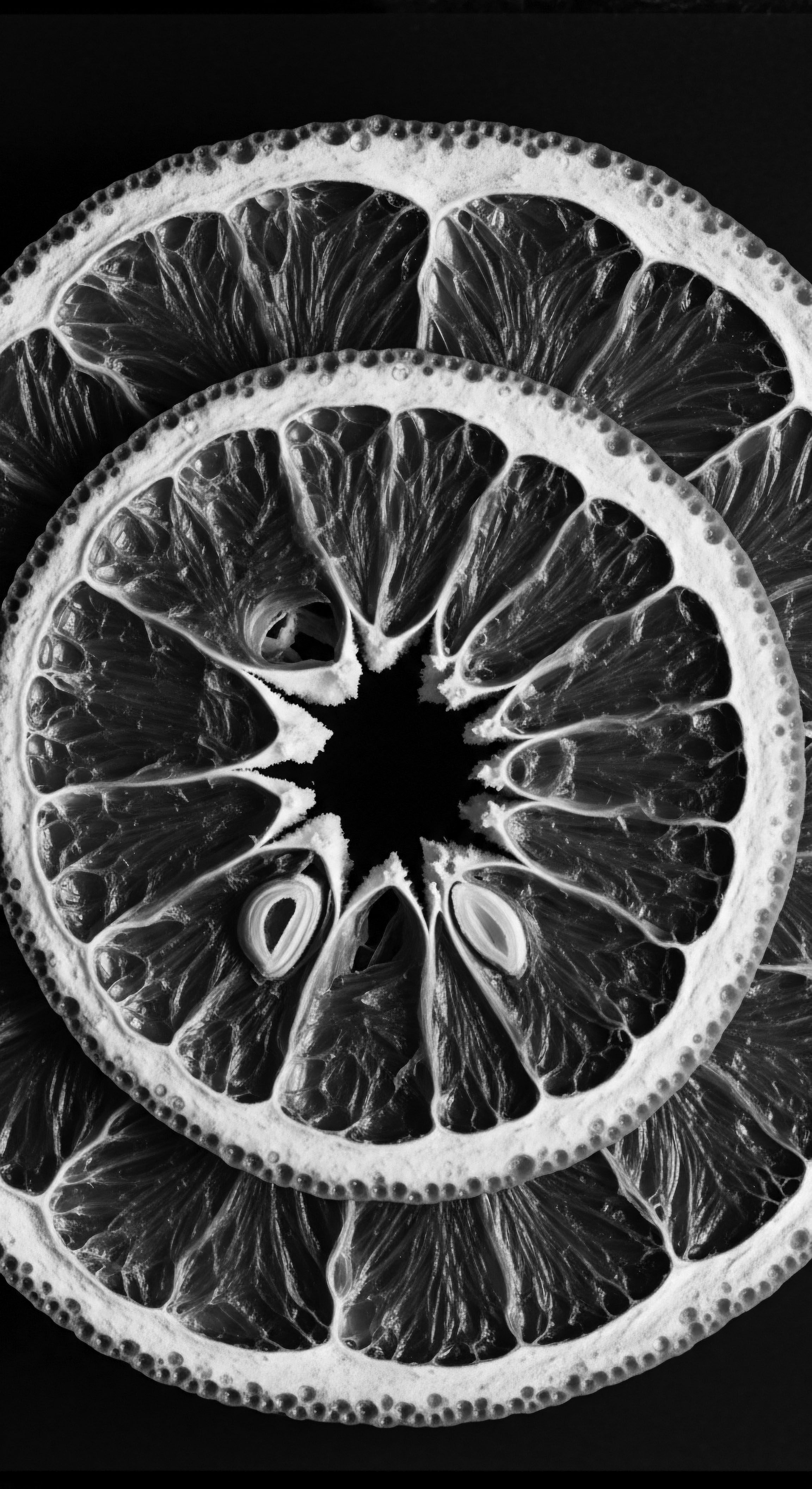
Scientific Underpinnings and Ancestral Ingenuity
The apparent “simplicity” of ancient hair care methods often belies a complex, intuitive grasp of hair biology. Textured hair, characterized by its elliptical shape and multiple twists along the shaft, is inherently more prone to dryness and breakage due to its structural properties, which hinder the even distribution of natural oils from the scalp. Ancient practices, such as the consistent application of plant-based oils and butters, served to mitigate this dryness by creating a protective barrier and sealing in moisture.
The widespread use of protective styles like braids, twists, and threading (such as the Yoruba’s “Irun Kiko”) minimized manipulation, reduced exposure to environmental stressors, and prevented tangling, thereby drastically reducing mechanical breakage and promoting length retention (Omotos, 2018). This demonstrates an acute observational understanding of textured hair’s vulnerabilities and strengths, long before microscopes revealed cuticle layers or chemical analyses detailed lipid composition.
Moreover, the ethnobotanical record reveals a vast pharmacopoeia of plants used for their medicinal and cosmetic properties related to hair and scalp health. Studies on traditional African plants used for hair care identify numerous species with properties that align with modern dermatological goals ❉ anti-inflammatory, antimicrobial, and even those with potential antidiabetic connections, hinting at a holistic understanding of scalp health as an extension of overall well-being (Traore et al. 2018; Maroyi, 2017).
This profound comprehension, accumulated over millennia, offers a rich repository of natural solutions that contemporary science is only beginning to fully appreciate and validate. The ongoing research into these traditional botanicals speaks to the long-term value and sustained relevance of Ancient Hair Care as a wellspring of innovation.
The meaning of Ancient Hair Care, from this advanced perspective, is thus a profound statement on human ingenuity and cultural resilience. It signifies a continuous thread of knowledge, meticulously preserved and dynamically adapted, which has empowered generations of textured hair wearers to celebrate their unique heritage. It represents a powerful counter-narrative to colonial attempts at cultural erasure, asserting the enduring value of ancestral wisdom in shaping identity and fostering well-being.
- Structural Preservation ❉ Ancestral techniques often prioritized styles that minimized stress on the hair shaft, reducing friction and environmental exposure.
- Moisture Equilibrium ❉ Consistent application of natural lipids and humectants helped maintain the delicate moisture balance inherent to textured hair types.
- Scalp Vitality ❉ Rituals often incorporated scalp massages and herbal treatments, promoting blood circulation and addressing various dermatological conditions.
- Community Cohesion ❉ Hair care served as a powerful social glue, fostering intergenerational bonds and transmitting cultural narratives.
- Symbolic Expression ❉ Hairstyles acted as complex visual codes, communicating social status, spiritual beliefs, and personal identity within the community.

Reflection on the Heritage of Ancient Hair Care
As we close this exploration within Roothea’s ‘living library,’ the enduring resonance of Ancient Hair Care stands as a powerful echo from our collective past, particularly for those whose strands carry the beautiful, intricate patterns of textured hair heritage. It is more than a mere collection of old recipes or forgotten techniques; it is a profound meditation on the very essence of self, community, and connection to the earth. Each traditional practice, each natural ingredient, whispers stories of resilience, creativity, and a deep, intuitive wisdom that understood the hair not just as a physical adornment, but as a vibrant extension of one’s soul and lineage.
The ‘Soul of a Strand’ ethos, which guides our understanding, finds its deepest expression in this ancestral wisdom. It reminds us that our hair, with its unique coils and curves, is a living archive, holding the memories of those who came before us, their struggles, their triumphs, and their unwavering spirit. The practices of Ancient Hair Care were acts of love, passed down through generations, nurturing not only the hair itself but also the bonds that held families and communities together. This heritage invites us to approach our own hair care with a similar reverence, recognizing the continuity of care that spans millennia.
The ongoing rediscovery and re-adoption of these ancient ways are not simply trends; they represent a conscious reclaiming of identity, a celebration of inherited beauty, and a powerful affirmation of self-worth. In a world that often seeks to homogenize, the wisdom of Ancient Hair Care offers a grounding presence, a reminder of the strength and beauty inherent in our distinct textures. It encourages us to listen to the whispers of our ancestors, to honor their ingenuity, and to carry forward this tender thread of care, ensuring that the stories held within each helix continue to speak to future generations.
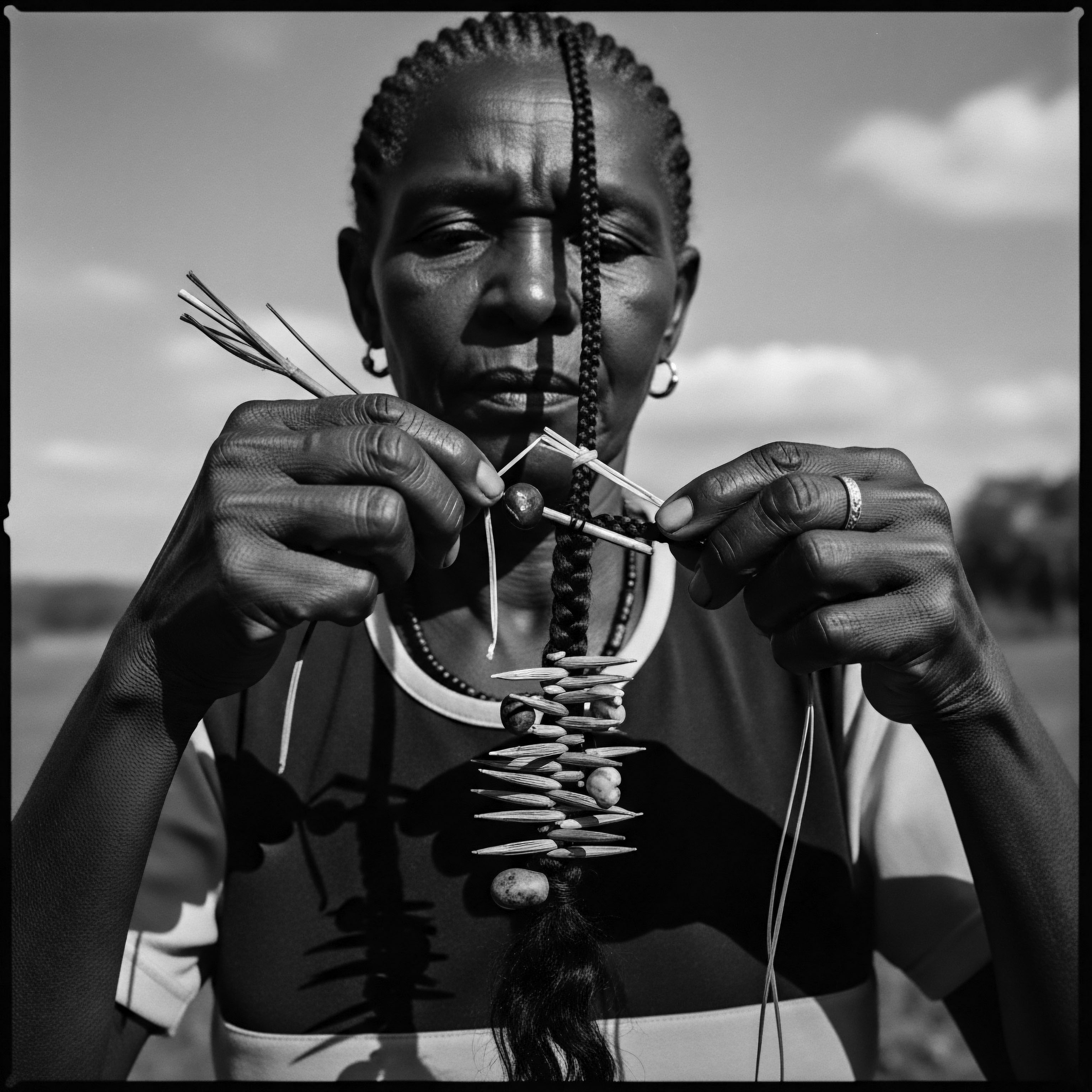
References
- Omotos, A. (2018). The cultural significance of hair in ancient African civilizations. Journal of Pan African Studies.
- Traore, A. et al. (2018). Ethnobotanical assessment and phytochemical review of herbal cosmetics knowledge of Arab-Choa and Kotoko ethnic groups in the semi-arid areas of Far North Cameroon. MDPI.
- Maroyi, A. (2017). Cosmetopoeia of African plants in hair treatment and care ❉ Topical nutrition and the antidiabetic connection? MDPI.
- Johnson, D. & Bankhead, T. (2014). Hair Story ❉ Untangling the Roots of Black Hair in America. St. Martin’s Press.
- Mercer, K. (1992). Black Hair/Style Politics. In Welcome to the Jungle ❉ New Positions in Black Cultural Studies. Routledge.
- Powe, L. (2009). Hair Matters ❉ African American Women and the Cultural Politics of Hair. University Press of Mississippi.
- Rosado, R. (2003). African American Women and Their Hair ❉ A Story of Culture, Identity, and Resistance. State University of New York Press.
